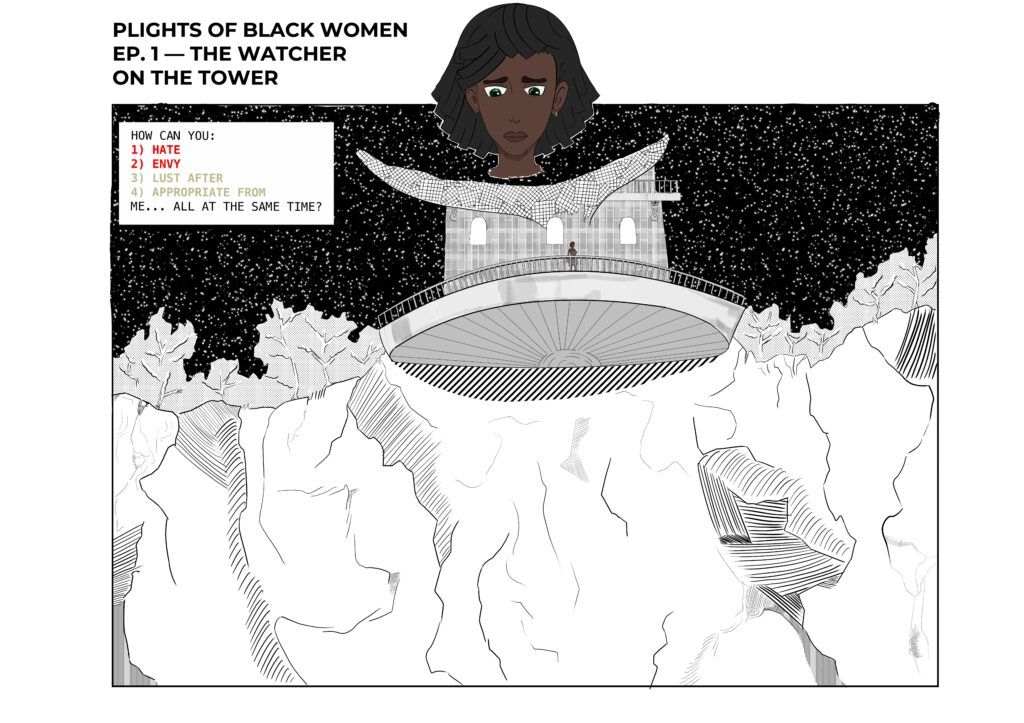The Repurposing of the Strike: Matriarchal Praxis
The Repurposing of the Strike (2021) was a proto-matriarchal political philosophy paper I wrote for Vanderbilt coursework. I synthesized the works of complex theorists into a single, cohesive argument; grounding high theory in brutal materiality — unpaid labor, historically anchored dispossession, and violence.

[N] A Contextual Preface
Before I wrote about matriarchal praxis, accelerated collapse timelines, and sovereignty on global stages, I was submitting essays like this.
I wrote this particular piece during my third year at Vanderbilt; for a final assignment in a thought-provoking political science class (PSCI 2201: Power and Resistance). Among other methodologies, I leveraged Verónica Gago’s strike insights for my own operationalized formulation — “continuity of struggle as both event and process” — and its integration into a broader framework of recursive resistance & temporal unfolding.
In hindsight, it reads less like an assignment and more like a draft of the frameworks I continue to build today.
Nested contracts.
Patriarchy’s long-standing alliance with capitalism.
The enduring qualities of collective struggle.
These are the same structures I analyze now on geopolitical, cultural, and economic levels.
The convergences I outline in my essay speak to why I’ve always found the term ‘feminism’ to be a strategic misstep, and it has nothing to do with misogyny.
We are told to parallel ‘patriarchy’ (rule of the fathers) with ‘feminism’ — a term that is inherently reactive, not foundational.
It fights on the enemy’s terminological turf. It asks, it pleads, it assimilates. Patriarchy is a system; an architecture of power.
The true antonym of patriarchy is matriarchy: not a demand for inclusion, but the construction of an autonomous counterweight — a sovereign architecture. Equality within a corrupt order is a loser’s game; it only makes you an equal participant in corruption.
Sovereignty is the only horizon: the power to define reality, value, and structure on your own terms. That is why liberal Euro-American feminism remains so hollow and ineffective. It was never designed to dismantle patriarchy, only to produce patriarchs in skirts.
To reject feminism in favor of matriarchy is not misogyny; it is the most radical form of care: refusing to settle for better terms under captivity, and instead architecting a new table, a new recipe, a new house.
Feminism is reaction.
Matriarchy is foundation.
Equality is a request.
Sovereignty is a declaration.
I’m sharing this not just as proof of intellectual consistency — my style and voice long predate today’s AI debates — but as evidence of something deeper: I’ve been preparing for this work, whether consciously or not, for a very long time.
[I] Proto-Matriarchal Beginnings
Women’s position in society has been at the forefront of discussion and contemplation since the dawn of humans. From their pivotal roles as childcare providers and gatherers of berries and other forest findables in the Stone Age to their kaleidoscopic range of roles in modern society — scientists, business owners, athletes, housewives, essential service providers, etc. — the female’s function in society has shifted and evolved. Throughout this evolution, there has existed a consistent line of violences against the female population; a line supported by a patriarchal society. And in the face of these unequal dynamics of power, so heavily contested and talked about in the modern day, we have seen the utilization of the strike by women as a means of advancement and breaking free of societal shackles.
The works of Verónica Gago, Rosa Luxemburg, and Saidiya Hartman provide us four crucial insights into the phenomena contributing to the reconfiguration of the strike by women. First, an alternative understanding of the origins of the woman’s struggle and place in patriarchal society. Second, this new understanding’s demonstration of womens’ transformation into the subject desiring the strike. Third, the place at which the strike is situated and the strike’s transformation into something that is both event and process through that situation. Finally, these elements’ escalating impact on the political and economic arenas.
[II] Historical Fabrications
Before understanding the subject (woman) that carries out the strike, it’s important to contextualize the background in which the subject decides to do it. As explained in Argentine activist Verónica Gago’s Feminist International, accounts by British political theorist Carole Pateman demonstrate that “by repeating the social contract as the origin of the political pact, women accepted a subordinated role under the covert form of a sexual contract… the sexual contract is that marriage contract that, in turn, operates in relation to the employment contract” (Gago 60).
The employment contract and (what I shall call) the prostitution contract, both of which are entered into in the public, capitalist market, uphold men’s right as firmly as the marriage contract. The two spheres of civil society are at once separate and inseparable. The public realm cannot be fully understood in the absence of the private sphere, and, similarly, the meaning of the original contract is misinterpreted without both, mutually dependent, halves of the story. Civil freedom depends on the patriarchal right… Capitalists can exploit workers and husbands can exploit wives because workers and wives are constituted as subordinates through the employment contract and the marriage contract. [8]
Carole Pateman // Researching Fellow @ British Academy // The Sexual Contract (Stanford University Press, 1988)
In other words, the patriarchy engaged in the creation of a male-centric, contractual dynamic between man and woman as part of a greater social contract – a matryoshka-esque situation wherein the sexual contract and employment contract nest inside the marriage contract, and the marriage contract nests inside the social contract. The sexual and employment contracts submit women to a promise of fidelity and unpaid work in the house (child rearing, cooking, housekeeping, and so much more).
Furthermore, the intentional complexity of these interrelations and articulating them is indicative of the obfuscatory power given to men by stitching this ‘origin’ story into the narrative. This power is an effective tool for the advantaged party (men) to impede the disadvantaged party’s (women) arrival at the root cause of these issues and deconstruction of these damaging patterns. Gago highlights the contract’s granting of another “specifically masculine power,” as referenced in Pateman’s account; in direct opposition to the female body’s more deferential role, the male body is portrayed as a “rational and abstract body with the capacity to create order and discourse” (Gago 61). This refers to a foundational idea: while women are given these responsibilities, men operate outside of this confinement of domestication the contract puts women into. Unburdened by these societal roles, men are free to create, lead, and order discourse in all other arenas.

The matryoshka of patriarchal contracts: the social norm encloses marriage, which in turn encloses sexual and labor obligations. Each layer adds obfuscation and reinforces women’s compounding subordination to unpaid domesticity.
A crucial component of the staying power of the social contract in society is the patriarchy’s establishment of a deceptive definition of the state of nature: “the theory of the social contract (which abstractly guarantees the order in which we live, and compels us to obey those who govern us) projects an idealized previous state that gives rise to it: the state of nature. In philosophical debates, it is said that this state is a sort of imaginary site” (Gago 60). This refers to the idea that what preceded the order of society was a nebulous and natural state; something to be accepted as easily as the Big Bang, and not to be looked at through a scrutinizing lens.
However, Gago’s postulations illustrate that this is a false premise, and that what preceded the social contract was much more tangible. As she explains, “women are the concrete reference for the materiality of the state of nature, due to the embodied form of their political existence, which in turn naturalizes and invisibilizes them” (Gago 60).
Rather than being an imaginary, nebulous state and therefore an easy tool of obfuscation for the patriarchy, the state of nature is validated by the realities faced by women in the sociopolitical arena (e.g., their role in the house and in child development, abortion rights, domestic violence and the laws surrounding it). It is through working with this true origin of the social contract we see the strings being pulled and the exploitation of the female body.
Furthermore, Gago postulates the idea that not only do these origin stories act as powerful tools of obfuscation and containment for the patriarchal society, but they also act as a cogent alliance for capitalism:
These ‘origin’ stories are mounted over material expropriations: conquests and appropriations of communal and Indigenous lands, conquests and appropriations of female and feminized bodies (of both slaves and migrants)… There is no confinement and impoverishment of women, no way of making them dependent and submissive, without a previous dispossession of their capacities for self-management and their own economies. Political creativity — in the alliance between patriarchy and capitalism — thus becomes a strictly male power based on an earlier expropriation. [61]
Verónica Gago // Professor @ University of Buenos Aires // Feminist International: How to Change Everything (Verso, 2020)
In other words, these fabricated origin stories — the relationship between the social contract and political order they establish — are predicated on an initial expropriation, an idea evocative of Karl Marx’s concept of private accumulation. His postulations loosely follow the idea that the original accumulation of capital preceding capitalism entailed the taking of land from a population and their subsequent displacement (Marx). It is important to note the stripping of autonomy and frequent cases of violence, rape, oppression, etc. experienced by women in this process. Tying this understanding of capitalism’s genesis back to Gago’s argument, the articulation of these two means of expropriation — carried out by the social contract and primitive accumulation — reveal the existence of an “alliance between patriarchy and capitalism” and the power it affords men.
[III] Capitalist Patriarchy
Rosa Luxemburg, writer of the pamphlet Reform or Revolution & The Mass Strike, provides a further elaboration on the ties between the female struggle and the battle against capitalism when she proclaims “”[W]ith the political emancipation of women a strong fresh wind must also blow into its [social-democracy’s] political and spiritual life, dispelling the suffocating atmosphere of the present philistine family life which so unmistakably rubs off on our party members too, the workers as well as the leaders” (Luxemburg 13).
Her attention to the suffocating nature of the family life women are subjected to and its interrelation to the worker class, as well as her allusions to its influences on the socialist movement, parallels concepts expressed by both Gago and Marx. The “political emancipation” of women, that Gago has highlighted as achievable through women’s use of the strike, will have shockwave effects on the makeup of the socioeconomy by way of removing said “atmosphere.”
In retracing the patriarchal society’s steps from the contemporary political order to its deceptive origin creations and exposing their underlying truths, we come to understand the female population as the subject of a perpetuating pain. Yet, despite this pain, a paramount message Gago conveys in her work is the rejection of the victim label: “To be a victim… requires faith in the state and demands redeemers. The strike puts us in a situation of struggle. It does not forget the importance of mourning, but it removes us from the state of mourning” (26).
She emphasizes the woman’s use of the strike as a means of reframing her status as a victim into one of a subject in a struggle. Gago’s insistence on a “struggle” reflects a careful use of terminology.
A struggle puts women in a process with a base goal of resistance and freedom, while victimhood illustrates a static condition; static in that the action that created said victim has already been carried out. There is nothing to do but rely on another’s power for a solution. The strike circumvents the need of the “state” and “redeemers” — that other, often patriarchal, power — in the process, giving agency back to the woman and taking her focus off of “mourning.”
[IV] The Strike's Arena: Expansion Through Critical Race Theory
Another pivotal part in arguing the nature of the strike and how it comes to be is explaining the arena in which it takes place. Gago describes this arena as an assembly with a two-part, simultaneous process. The assembly is both a “situated apparatus of collective intelligence” and a “political process, not as an isolated event on the calendar” (Gago 158). First, assemblies allow for a collective thinking with an inherent newness to them due to the strike’s spontaneity. Furthermore, Gago underlines the arena’s facilitation of the strike’s unique temporality when she states, “[collective thinking as a result of the assembly] ties together diverse elements, it evaluates tactics, it composes strategy. It is inscribed in the history of past struggles at the same time that it is experienced, I insist, as new” (Gago 158).
In the strike’s formulation of a body in a distinct point in time, it pulls from a wide variety of individual experiences. Through this, the strike connects the present to the past, stitching together continuity from discontinuity. It’s a process reminiscent of the previously articulated stitching of the false origin into the narrative by the patriarchy, and therefore a quintessential example of Gago’s portrayal of the strike as a counter-power. This continuity substantiates the assembly’s second function as a “political process,” where each strike involves an update of the body of struggles. New cases of violence against women occur on a daily basis; one in four U.S. women are subject to this endemic issue.
Saidiya Hartman’s “The Anarchy of Colored Girls Assembled in a Riotous Manner” provides a black perspective of the woman’s constant struggle in the early 1900s through Esther Brown, during times of racially targeted directives such as vagrancy laws:
The acts of the wayward — the wild thoughts, reckless dreams, interminable protests, spontaneous strikes, nonparticipation, willfulness, and bold-faced refusal redistributed the balance of need and want and sought a line of escape from debt and duty in the attempt to create a path elsewhere. [470]
Saidiya Hartman // Black Writer & English Professor @ Columbia University
Her account supports Gago’s assertion of the women’s strike as being two things at once. First, Hartman expresses the unique, black perspective of the female struggle with violences. Second, the similar sense of fervor and unity present in both the black woman’s strike and the strikes in Latin America demonstrates how Esther Brown’s experiences become a part of a larger body of connected violence, strengthening the part and the whole. It is indicative of the presence of continuity in the temporality of the woman’s struggle and carrying out of the strike, corroborating Gago’s argument.
[V] A Collective Struggle
Thus far, we’ve explored the nature and foundational aspects behind Gago’s novel theorization of the strike through the true origins of the social contract, the patriarchy’s base connections to capitalism, the arena in which it occurs, and its influences on its temporality. And while this is important, demonstrating the contemporary significance, as well as practices, of this novelization is another essential step in understanding Gago’s novel theorization. As she explains, “the strike is an exercise of mass suspension and sabotage of the political economic order” (Gago 26). Simply put, a strike impedes and works on deconstructing what the patriarchal society has so far established for man’s benefit. On-brand with the theme of rejecting victimhood status, women utilize the strike as a shield and sword against the patriarchy-led status quo.
Gago’s use of the term mass suspension underscores a greater implication that when not minimized and invisibilized, the female’s role in society is revealed to be much greater than currently accredited. This implication complements her later reasoning that “mapping the strike thus becomes a tool for [visualizing] hierarchies of work in a feminist register” (Gago 29). This refers to the overarching issue of female forms of labor commonly being portrayed as ancillary to wage labor and its products. The status quo’s “hierarchy of work” is undoubtedly male-centric. Gago touts the strike as a means of turning the order on its head and keeping in line with the feminist movement’s rejection of “the premise that workers are only those who receive a wage” (Gago 58). As she frequently highlights throughout her work, there is a wide range of “work” not included in wage labor — rearing of children, cleaning the family house, cooking, etc.
Ultimately, the novel theorization of the strike created by Gago in her work both establishes a truer narrative of the context behind the unequal dynamics of power faced by the female population and a rigorous analysis of the process of breaking free from society’s ‘order.’ She provides a nuanced understanding of the strike and how the struggles of women across the globe act as not only an anchoring tool for the movement, but also as a powerful connector. Hartman and Luxemburg’s account only further emphasizes that connection across the globe, as well as the interrelatedness of the feminist movement to topics such as racism, slavery, and capitalism.
References
- Gago, Verónica. Feminist International. Verso, 2020.
- Hartman, Saidiya. “The Anarchy of Colored Girls Assembled in a Riotous Manner.” The South Atlantic Quarterly. 2018.
- Luxemburg, Rosa. Reform or Revolution & The Mass Strike. Haymarket Books, 2008.
- Marx, Karl, and Ben Fowkes. Capital. New York: Penguin Book, 1976.
-
Pateman, Carole. The Sexual Contract. Stanford: Stanford University Press, 1988.

